

Bill "Hardpan" Lane |
ollywood's entry into professional baseball began when the Salt Lake City Bees moved their franchise to the movie capitol after the 1925 season, under the ownership of Harry William "Hardpan" Lane (1860-1938), who claimed to have been—in addition to an explorer and an Indian fighter—a prospector who had struck gold in the Yukon Territory at the turn of the century (in truth, he'd studied mining law and made most of his money buying up depressed businesses in Idaho and Utah). But Hardpan's true passion was baseball. He bought the PCL's Sacramento Solons with a group of investors, and they moved them to Utah in 1915. Lane then slowly bought up all of his partners' shares at reduced rates as the team floundered financially during World War I, and eventually became the sole owner.

The Ogden Standard-Examiner, Nov. 1, 1925. |
In Salt Lake City, Lane's club had a tiny fan base, but the highest-scoring roster in PCL history. In 1925, future Hall-of-Famer Tony Lazzeri set the league record of 60 home runs over 192 games, along with a .355 batting average and 222 runs batted in—the most RBI's in professional baseball history. Lane and the team's business manager "Spider" Baum promptly sold Lazerri to the New York Yankees for $125,000 (fifty grand in cash and two players), where he became part of "Murderers' Row" with Babe Ruth and Lou Gehrig.¹
Lane wasn't done with the fire sale, however. In one memorable afternoon, Lane sat in a box seat with William Wrigley during a game with the Los Angeles Angels. Wrigley owned the Angels in the PCL, and the Chicago Cubs in the National League back east. Haggling as they watched the game, Lane sold Lefty O'Doul, who was hitting .375 with 24 home runs, to Wrigley's Cubs for $50,000—and then added pitcher Bill Piercy for another $25,000 as an afterthought. Lane wasn't just selling off his greatest assets for cash, however. He was using the money to get the whole team out of Utah, and move where the fan base would be larger and the train travel would be much cheaper.
Sensing an opportunity, Wrigley then offered Lane the use his brand new million dollar stadium in Los Angeles, Wrigley Field, whenever his team was on the road. Basically the teams would have opposite schedules, and Wrigley would get part of Lane's take back at home while the Angels were out on the road. Furthermore, when the two teams played each other at Wrigley Field there would be a built-in rivalry to spur fan attendance.
Lane agreed to the deal, but instead of moving the now-severely depleted Bees, he first attempted to buy the Vernon Tigers in Los Angeles with the cash from all the players he sold. That deal fell through, however, and the Tigers instead were forced to relocate to San Francisco, renamed the Mission Reds. With that option gone, Lane moved what was left of his team 700 miles south, near the California coast.
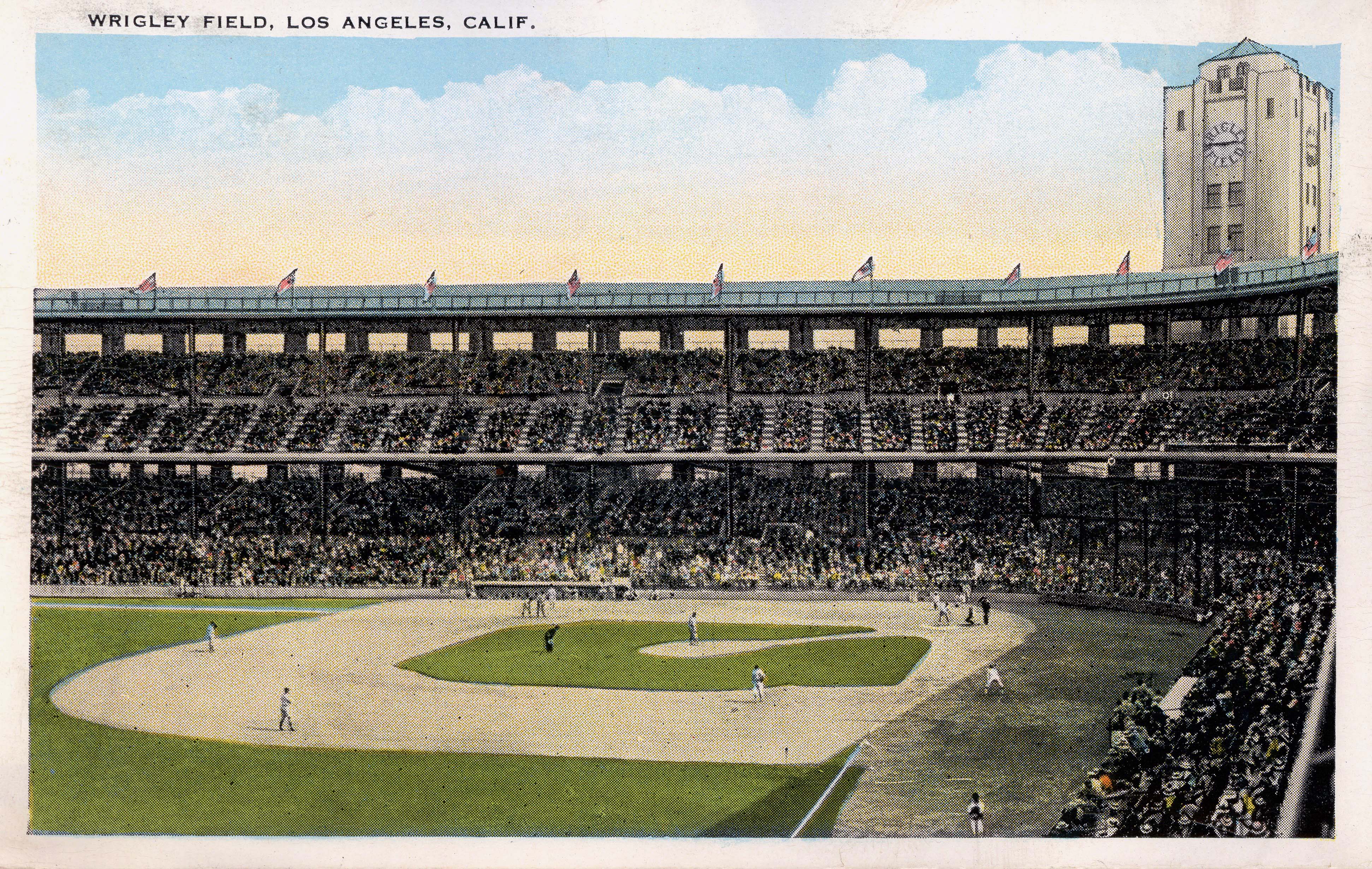
Although the Stars were supposedly based in Hollywood, they first played miles away in Wrigley Field—the home of the rival Los Angeles Angels.

Ogden Standard Examiner, March 31, 1926 |
Bidding was fierce for the naming rights of the team among Western cities. The city of Hollywood beat out Glendale and Long Beach (even though their home base of Wrigley Field wasn't close to any of those cities), winning with their promise of building a new ballpark on land owned by the Gilmore Oil Company.² It was agreed that Lane's team would play in Wrigley's ballpark until the new stadium was built.
At first the team was still called the "Bees," then the "Sheiks," but "Stars" seemed like the obvious name, and the uniforms were changed as a concession to popular opinion—even though they were playing across-town from Hollywood and no "stars" were attached to the team. In 1928, they became the first professional baseball team to fly when it was determined they wouldn't have enough time to ride by train back to California for a home game.³ The Stars finished among the top three teams for seven consecutive years, with so many .300 hitters that Manager Oscar Vitt was unable to play them all at once; his pennant-winning 1930 club had ten of them!
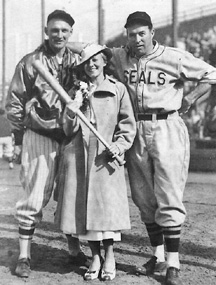 Frank Shellenback, infamous "fan dancer" Sally Rand (holding a bat very suggestively), and Lefty O'Doul of San Francisco. Frank Shellenback, infamous "fan dancer" Sally Rand (holding a bat very suggestively), and Lefty O'Doul of San Francisco. |
Among the notables who played for the Stars were O'Doul—who batted .338 with 20 homers for the Stars—and Hollywood High graduate and spitball ace Frank Shellenback, who is ranked by many as the greatest PCL pitcher of all time. After a stint with the Chicago White Sox in 1918 and 1919 (the "Black Sox" year), Shellenback traveled west when the spitball was outlawed in the major leagues. Shellenback never tried to return to the "Eastern League" without his best pitch. Instead, he dominated the PCL, averaging almost 24 wins a season for six years in the 1920s, and an incredible 33 out of 34 games in the 1930-31 seasons.⁴ Teammate (and eventual MLB Hall-of-Famer) Bobby Doerr recalled, "There were slippery elm tablets he'd suck on. He would spit on a spot on the ball and it was real slick—and once in a while in the infield you'd grab the ball where that was and throw a 'spitter' to the first baseman." Shellenback won 295 games over the course of his career—205 for the Stars.

Clara Bow bats before the usual packed house for a Stars game.

Proof that the stars weren't always hip. |
Hollywood won the PCL pennant in 1929, beating the Mission Reds in a post-season playoff, and won the pennant again in 1930. But it's hard to build a fan base when you play in another team's stadium—especially during a Depression.
Things got so bad that in 1935, Lane had to ask Vitt to resign in order to save money, and utilized Shellenback as a player-manager. The move was a disaster, and not only did the Stars finish in last place, they only drew 90,000 fans all year. (To show you how much attendance had dropped off, 80,000 fans had attended a seven game series against the Angels at Wrigley Field just five years earlier.) Worse yet, Wrigley was tired of sharing the ballpark with a failing team, and Lane was informed that the rent at Wrigley Field was going to double. He simply couldn't afford it, and decided to move back out of town.
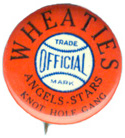 |
Lane received offers from Sawtelle (West Los Angeles) and Salt Lake City, but decided to gamble on San Diego, which had not fielded a professional baseball team for 35 years. So the franchise moved 100 miles south and became the San Diego Padres.⁵ Lane was horrible at marketing, but his nose for baseball talent was still remarkable—the next year, the Padres won their first PCL title, led by a young pitcher-slugger that they signed out of the local high school... named Ted Williams.
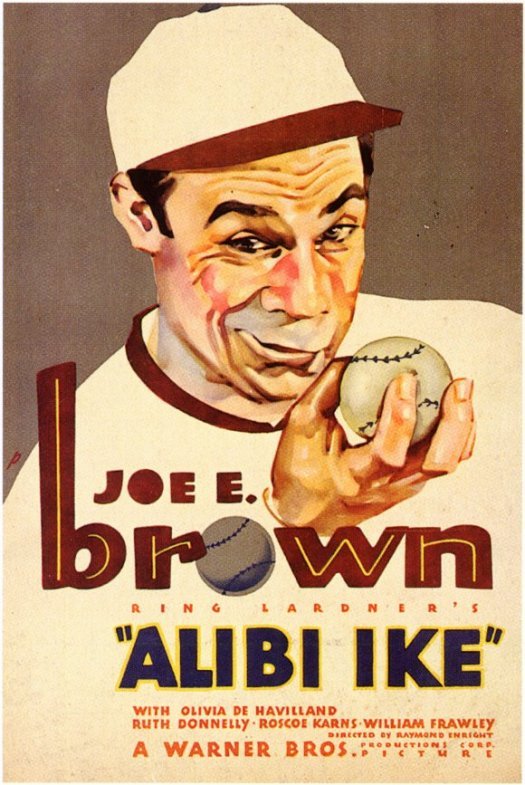 |
On the last day of the 1935 season, the Stars trailed the Missions 14-7, with two out and nobody on in the bottom of the ninth. In a surprise move, actor/comedian Joe E. Brown, a former semi-pro player who starred in baseball films like Alibi Ike and Elmer the Great, came to the mound for the Stars to pitch to songwriter Harry Ruby, who had just co-written a film for the Marx Brothers called Duck Soup. Being a top-ten box office star with matinee-idol looks to protect, Brown called in the outfielders and positioned them in front of him as protection from line drives. He needn't have bothered, as he whiffed Ruby to close out the season—and close out this iteration of the Stars, who would soon leave for San Diego. |
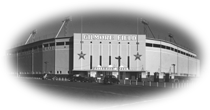 | '38: STARS REBORN |
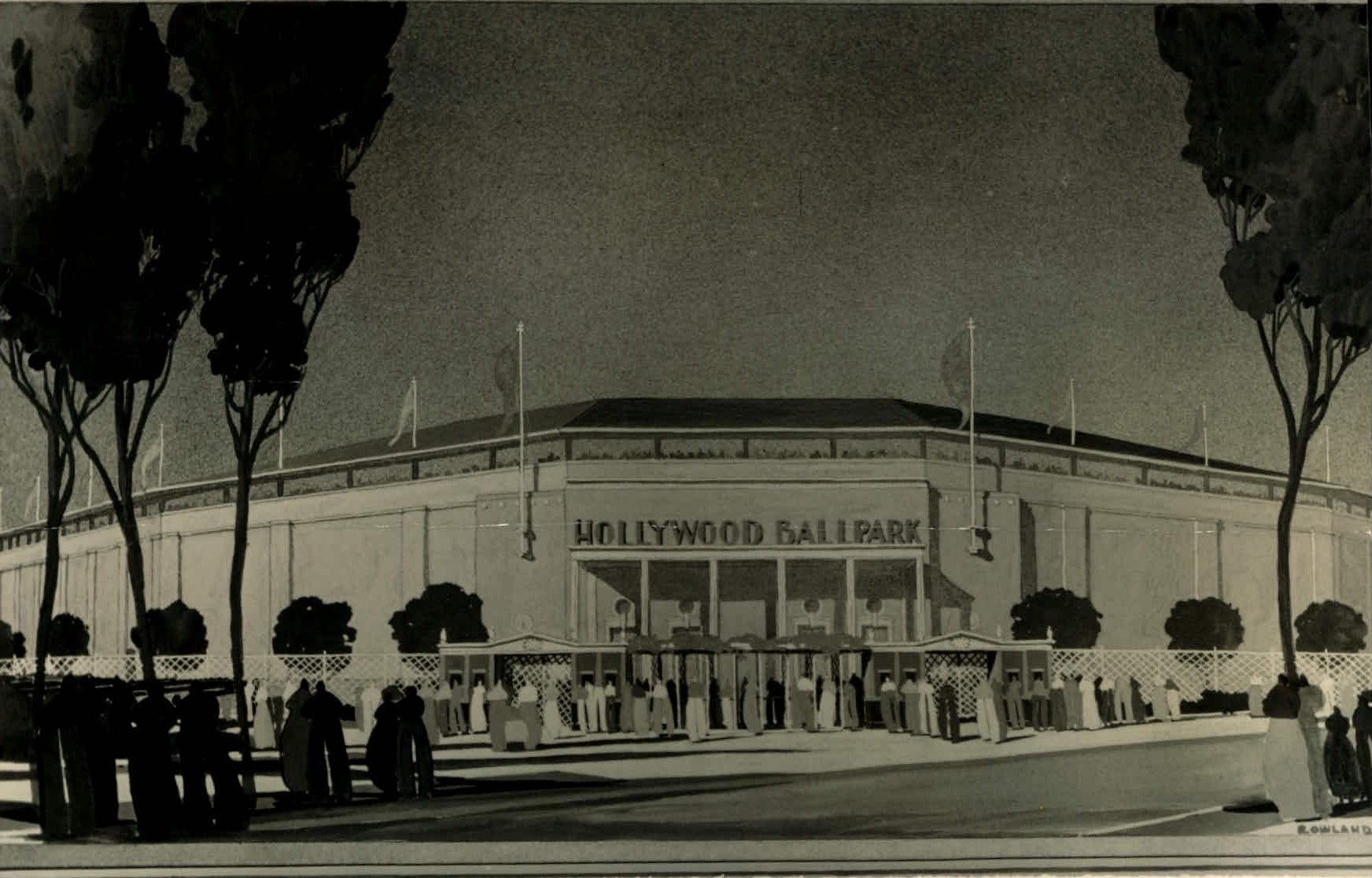
Early design for Gilmore Field (then "Hollywood Ballpark") in 1938.
Hollywood went without baseball until 1938, when the Mission Reds (previously named the Vernon Tigers, who had played just north of Los Angeles, under the ownership of Fatty Arbuckle) returned to Southern California and, in an effort to fake some sort of continuity, took over the name of Lane's "Hollywood Stars." But the team was terrible, finishing last, and so cash-poor that when they finally bought a decent player—Danny Bell of the New York Yankees—they couldn't raise the funds for his purchase price and had to send him back. Soon they were selling players just to pay their bills. Finally the management team dissolved. So the Stars were sold again—this time to attorney Victor Ford Collins and restaurateur Robert H. "Bob" Cobb (the guy the Cobb salad is named after), the vice president and general manager of the Brown Derby, the most popular high-end eatery in town.⁶
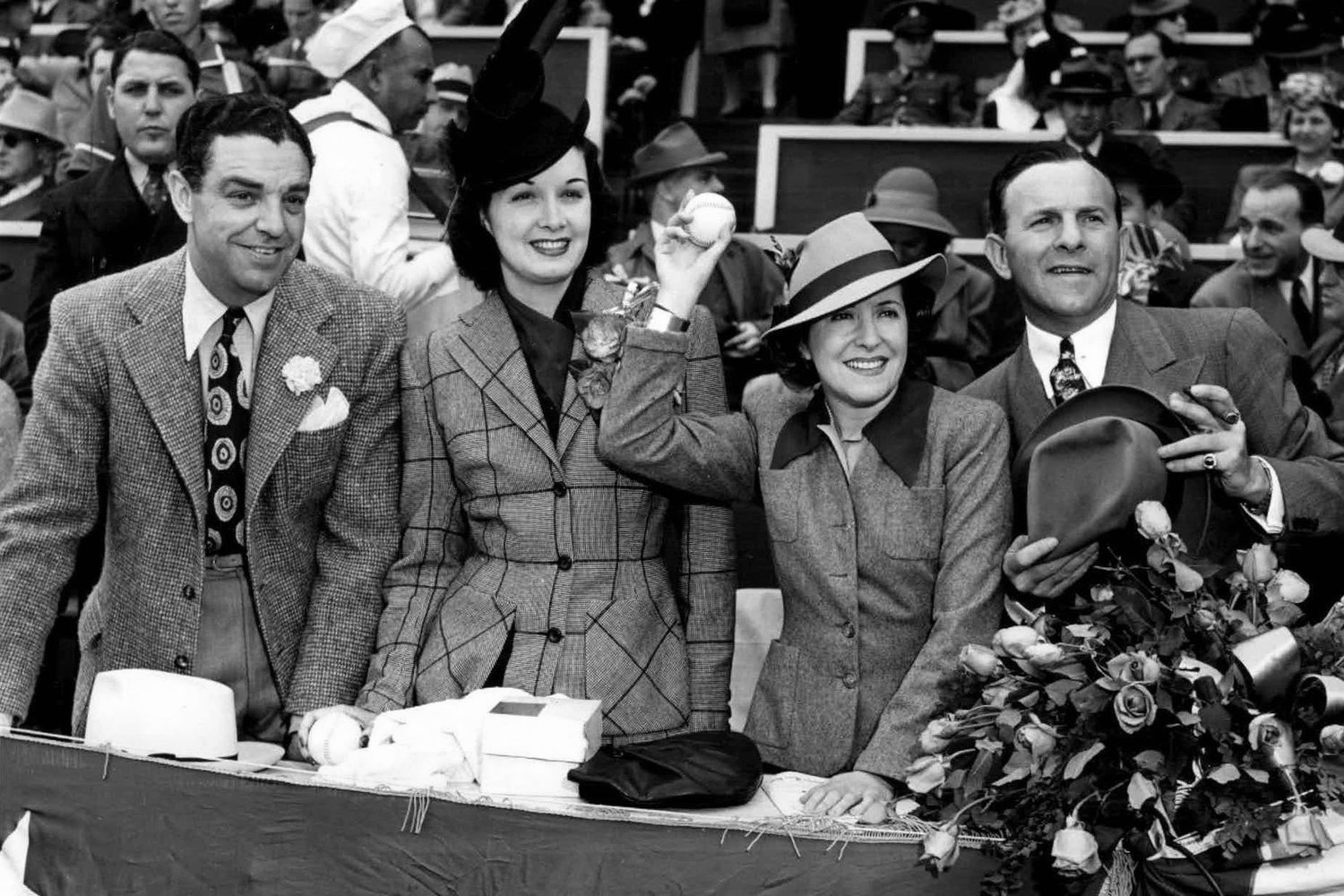
Owner Bob Cobb and his wife, Gail "Ma" Patrick, with Stars investors Burns and Allen.
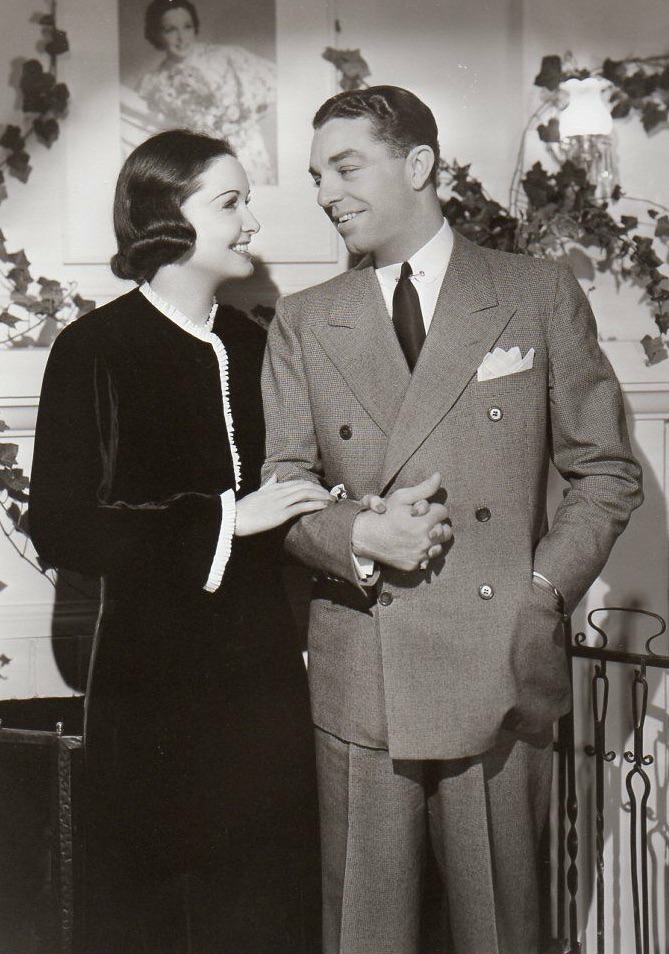
Gail Patrick and Bob Cobb at home. To beautify the room they installed... a portrait of Gail Patrick. |
Cobb and Collins formed the Hollywood Baseball Association, and started devising ways to raise money for the team and secure a new ballpark. The most important method they used was to sell stock in their Association to movie stars and civic leaders in Hollywood, in an effort to create a community-oriented franchise. In this way the team would truly represent the city (as well as benefit from a lot of publicity). In fact, they were probably the first baseball franchise in which the owners had a larger fan base than the team!
Cobb's wife, Gail Patrick, was the secret weapon for the last place Stars' sudden popularity with the Hollywood elite. Cobb ran their favorite restaurant, meaning he offered them a service, but Patrick was one of them—best friends with Carole Lombard and Barbara Stanwyck, a "Paramount Protegé" of 1935, and a popular "bad" girl in dozens of films like My Man Godfrey (1936) and Stage Door (1937). As the husband of Patrick, Cobb was suddenly a peer to these potential investors, partying with them at entertainment events instead of just serving the food. Now he came to them as an equal he could offer a partnership in the club.⁷
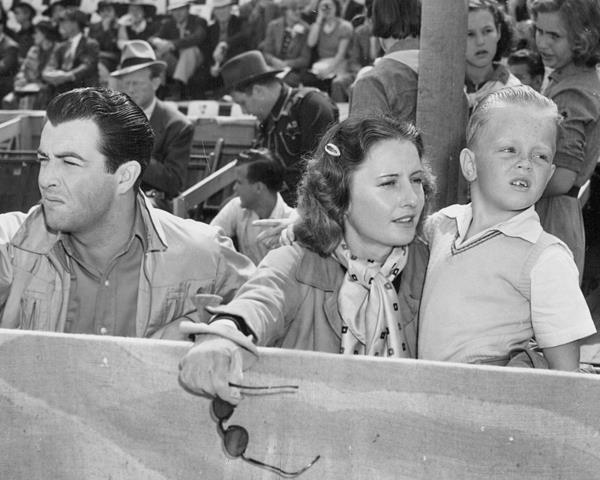
Stockholders Robert Taylor and Barbara Stanwyck take her son to LA's Wrigley Field in 1938.
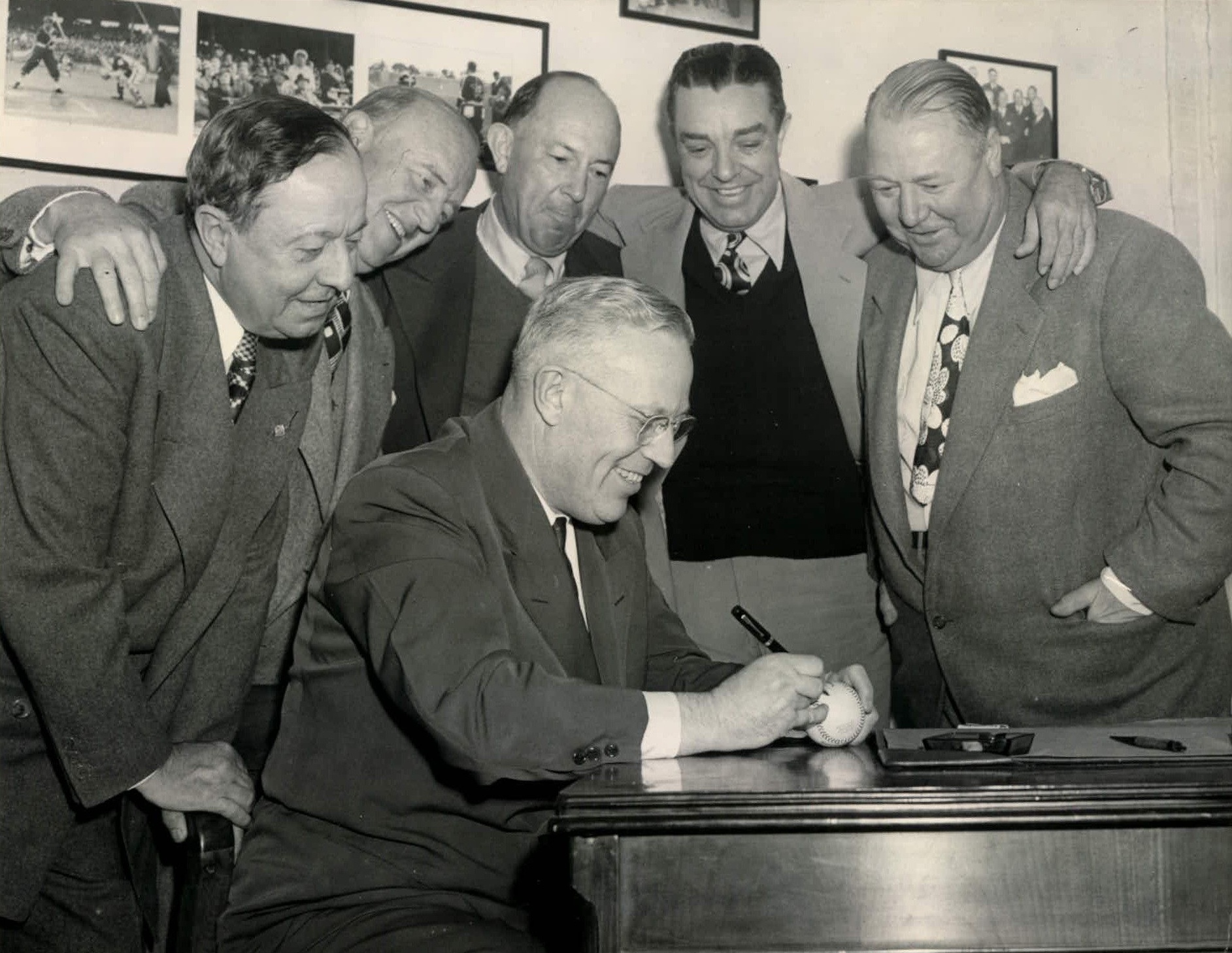
Governor Earl Warren signs a ball for PCL President "Pants" Rowland, Stars investor Bill Frawley ("Fred Mertz" in I Love Lucy), club president Victor Ford Collins, Cobb, and chairman George Young. |
This was obviously not your average group of minor league investors: Board meetings were held at Cobb's elegant Beverly Hills restaurant or aboard auto magnate Frank Muller's yacht, and the Chairman of the Board of Directors was Cecil B. DeMille. There were 43 stockholders in all, including Patrick, Stanwyck, Taylor, Gary Cooper, Bing Crosby, director Lloyd Bacon, Walt Disney, Warner Bros. president Harry Warner, Paramount production chief Bill LeBaron and Leon Schlessinger (producer of "Loony Tunes"). The Stars signed a deal to play at Gilmore Stadium, which was used for midget auto races, and then paid $200,000 towards the construction of a new ballpark, called Gilmore Field (named after Earl Gilmore, an oil tycoon who owned the site), to be built next door...
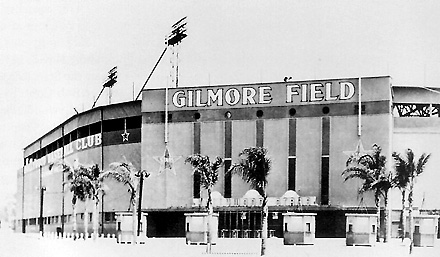
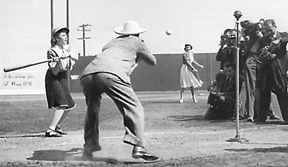
Gail Patrick fires; Jane Withers bats; Brown bails out. |
The lovely Gilmore Field opened on May 2, 1939, at 7700 Beverly Boulevard in Los Angeles, with all the fanfare of a Hollywood premiere. Jack Benny, Al Jolsen, Gary Cooper, Robert Taylor and Bing Crosby hosted pre-game festivities, and Gail Patrick threw out the first pitch to movie comedian Joe E. Brown. Also in attendance: Jack Benny, Buster Keaton, Rudy Vallee and Walt Disney. There was no Hollywood ending, however—the Stars lost to the Seattle Rainiers, 9-5.⁸ Still, the franchise quickly caught on and became very popular with Angelinos in the post-World War II economy.

Spencer Tracy and wife | 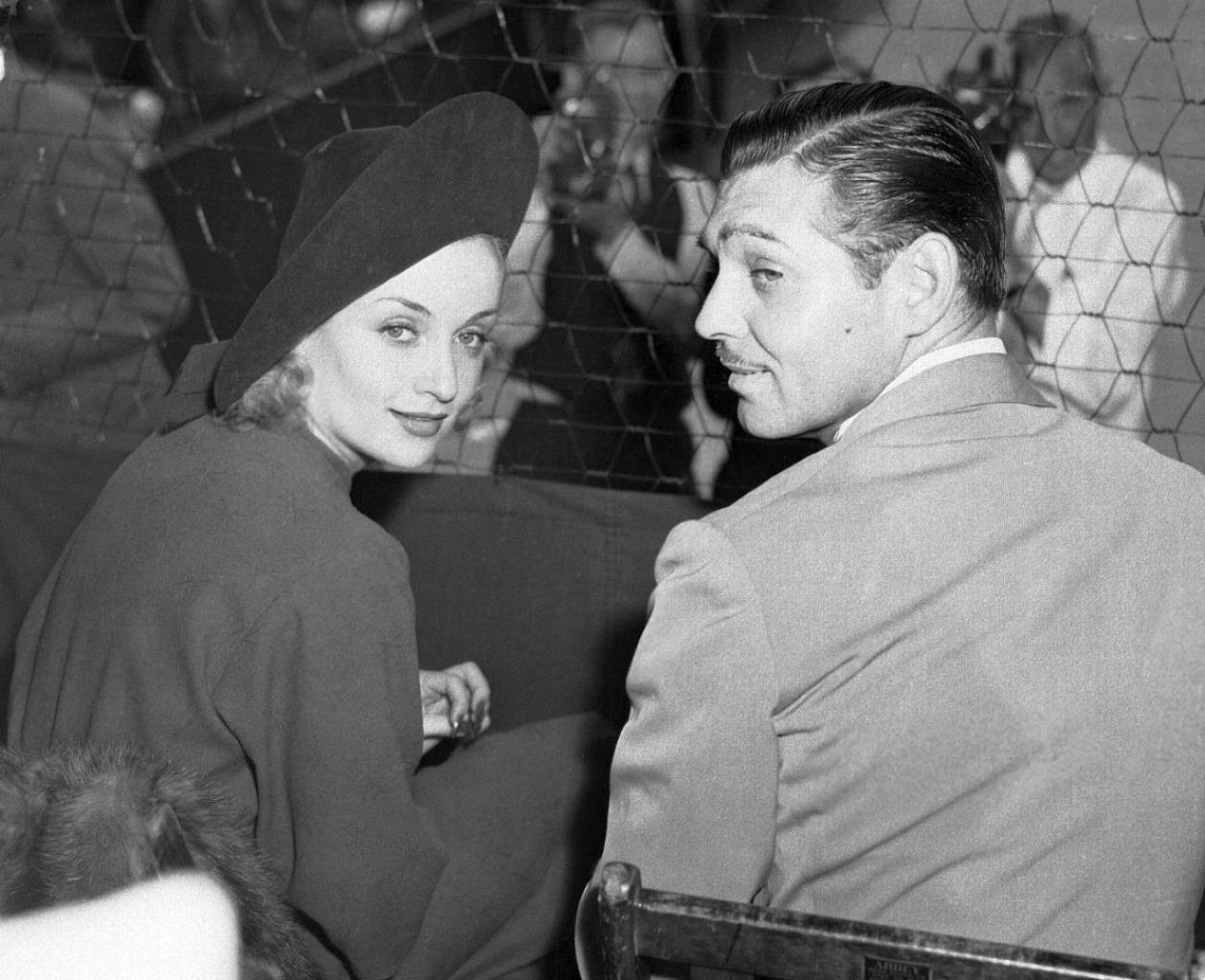
Gable and Lombard |
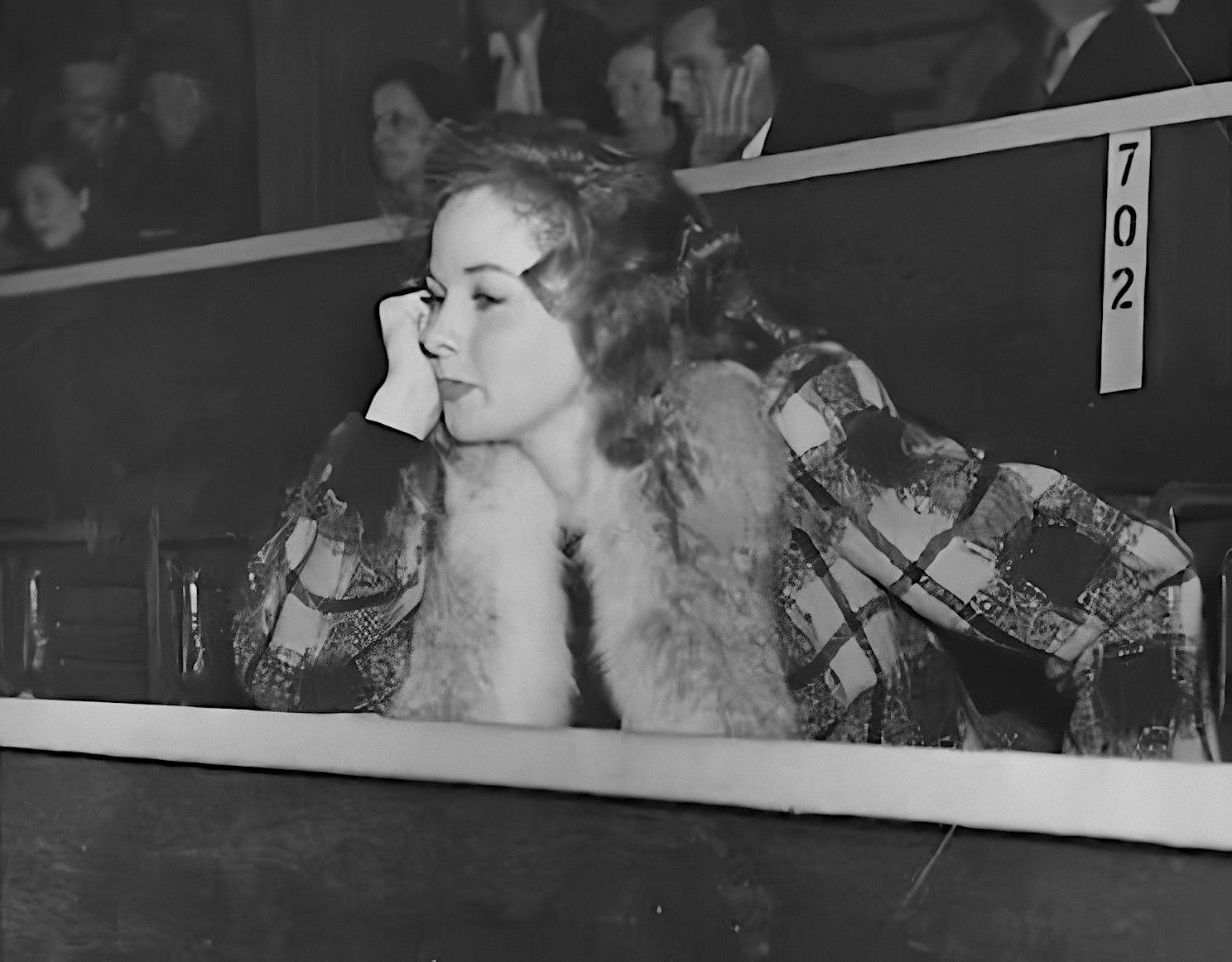
Susan Hayward, all alone at third. |
Much like what you see at the Laker games of today, Hollywood denizens attended Stars games to see and be seen. It was said more beautiful women attended games at Gilmore than anywhere else in the minor or major leagues. Celebrities like Spencer Tracy, Milton Berle and Rosemary Clooney were often seen in the grandstand of the stadium—as were gangsters like Benjamin "Don't call me Bugsy" Siegel. Regulars at the park over the years included George Raft, Groucho Marx, Marilyn Monroe, Humphrey Bogart, Bob Hope, Lucille Ball and Desi Arnaz. Each had his or her name on a plaque affixed to their seat. Gail Patrick had a box seat near the Stars dugout where she would rub 22 rabbit's feet superstitiously (one for each player). A special VIP room under the stands made it easy for them to socialize and drink harder stuff than soda pop between innings without pesky fans pestering them for autographs (and where after games, they could pester the players for their's).
|
The 11,500-seat Gilmore Field was possibly the most intimate metropolitan ballpark ever built. First and third bases were 24 feet from the front row seats; home plate was only 34 feet away. Fans seated in the bleachers carried on running conversations with the outfielders—even during the game. But it was more intimate in that there were large gaps between the wood planks in the stands, and players relaxing under the bleachers for the seventh inning stretch could tell if any woman standing above them in a dress was wearing panties or not. Carlos Bernier would return to the bench with cigarette ash and peanut shells in his hair, and everybody knew where he had been.
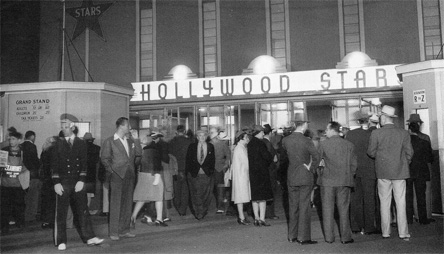
|
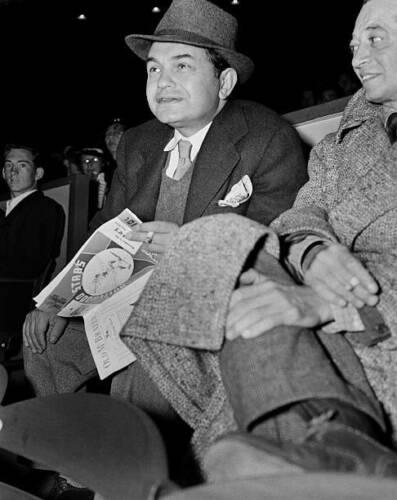
Edward G. Robinson and Peter Lorre. |
There were some bumps along the way, stemming from the fact that the investors and board members on the Stars were not experienced baseball people. They were entertainers who had not risen through the baseball ranks, were used to getting whatever they asked for—immediately—and would demand to hire and fire Hollywood's managers on a whim. As one reporter put it (probably in a subtle dig at Gail Patrick), the Stars tired of managers "as women do of hats." For instance, in October of 1941 the Detroit Times reported that minority investor William Frawley (later "Fred Mertz" in I Love Lucy) had hired retired Hall of Fame Tigers catcher Mickey Cochrane to manage the Stars—as well as succeed Victor Ford Collins as president of the team... without informing the Stars of doing so. Collins and the Stars' business manager dismissed the report and stated that Frawley lacked authority for hiring negotiations or decisions, and it required some delicate public relations finessing to let all the parties down easy. However, for every incident like that, the infusion of new ideas generated by Cobb and media-savvy show business people on the Board to attract publicity and draw crowds led to many more successes:⁹
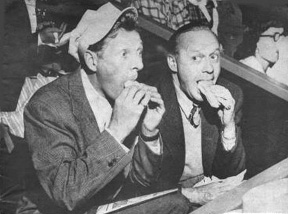
Danny Kaye and Jack Benny try the 'electrified hot dogs.' They forgot the rubber tongs! |
- With the owner of the Brown Derby in charge, there was a big change in the ballpark cuisine; Cobb was not about to settle for underwhelming ballpark food. He ordered Danny Goodman, who was in charge of concessions and promotions at Gilmore Field, to offer more exotic offerings... but much to Cobb's chagrin, the concessioners had to go back to the cheap hot dogs and hamburgers that the stars grew up eating at ballparks and preferred while watching a game. Still, Cobb demanded that the peanuts only be sold hot, with a prize inside each bag. He demanded rich milk buns for the "electrified" hot dogs, as well as fresh donuts, and the ice cream had to have an acceptible fat content for flavor.¹º
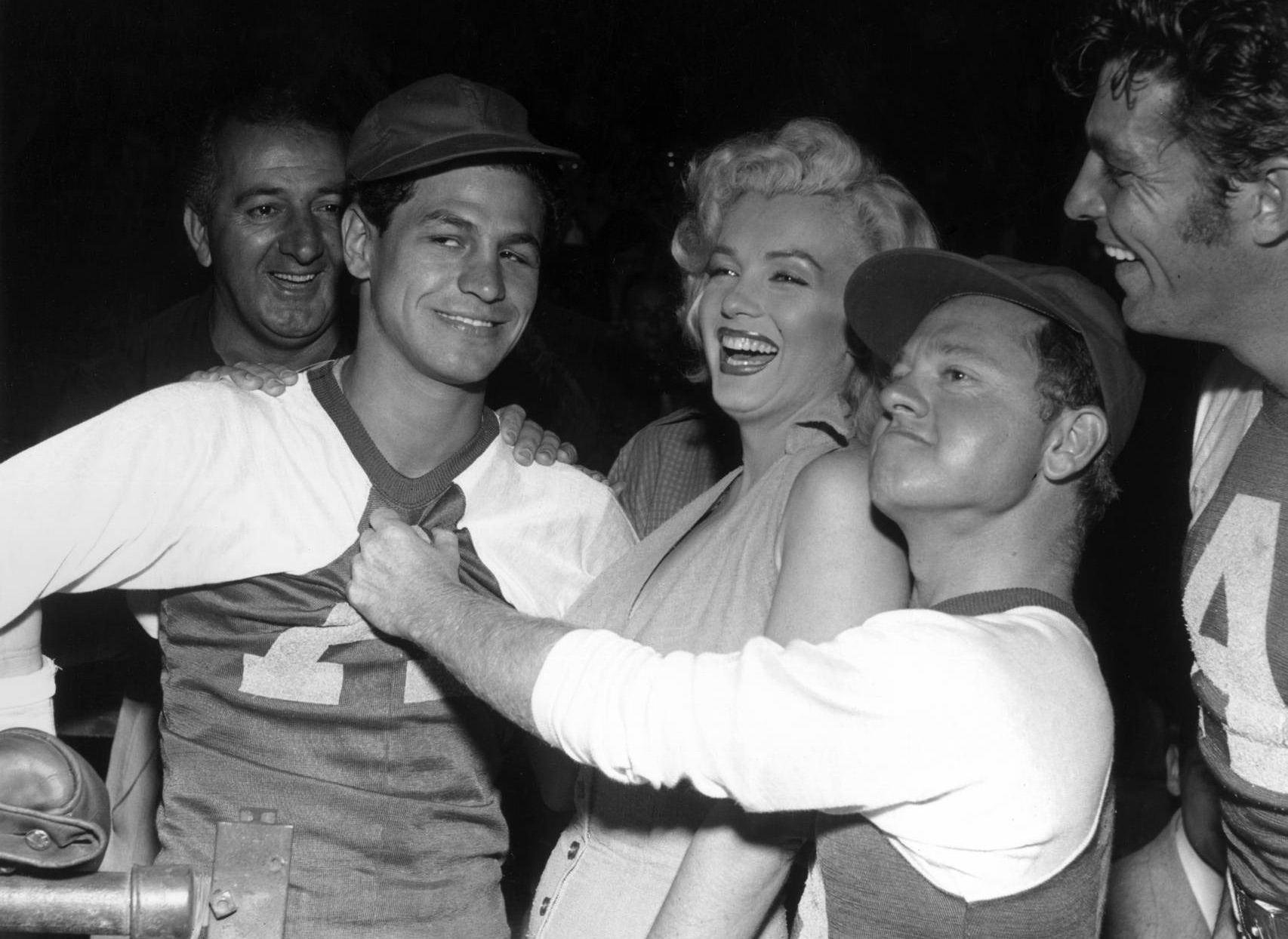
Boxer Art Aragon, Marilyn Monroe, Mickey Rooney and Dale Robertson in 1952. |
- A celebrity game, aka, a "Hollywood Stars vs. Hollywood Stars" night. It was the brainchild of Goodman. He suggested using the celebrity minority owners of the team to play in a game at the ballpark, and a long tradition began. When the Dodgers relocated to Los Angeles, they hired Goodman in the same capacity and he suggested that the "Hollywood Stars" game promotion could be continued. Owner Walter O'Malley asked, "Will you be able to get the stars?" Goodman, perhaps missing the point, replied, "Are you kidding? I'll get you stars you've never heard of!"¹¹

"Many of Disney's animated cartoons have been based on sports subjects, but he admits baseball is his favorite sport and the Stars his favorite team." |
- "Bat Night" was a major event for the fans, because the owners helped distribute the prizes—so not only did you get a free bat, you were handed that bat by Bing Crosby or Veronica Lake!
- The Stars installed an advanced lighting system by General Electric and instituted night games during the week, so the stars (movie stars, not Stars players) could amble over from CBS and the studios to watch a game after a hard day of work.
- The PCL was a California-based league, but there were teams in Oregon and Washington that had to travel 500 miles by train or bus to play down in LA and San Diego. Cobb avoided the grueling travel schedule by chartering planes for the players, in exchange for advertising the airline on the outfield fence.
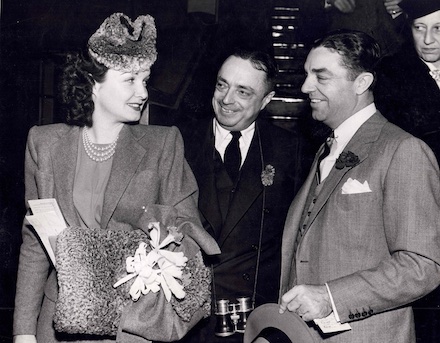
Gail Patrick charms creepy Sporting News publisher Alfred H. Spink with a side-glance; Bob Cobb just beams. |
- Another innovation was broadcasting the games on television, in 1940. Now, there were only a few hundred TVs in L.A., and one new experimental TV station that would eventually be KHJ-Channel 9, but fans could watch the games at the Brown Derby, and crowds of people in Long Beach were watching games in a store window and spilling into the street. In the 1950s, Cobb's (now-ex) wife Gail "Ma" Patrick hosted a popular post-game TV show. The Stars were a hit!
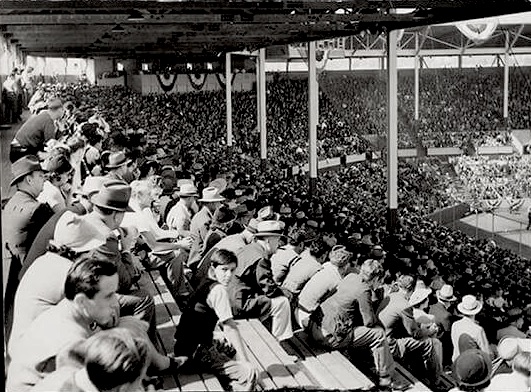
The Glory Years: The Stars win the hearts of Hollywood and dominate the PCL in PART TWO:


|
NOTES ON THIS PAGE:
¹—"Coast League Grad," Oakland Tribune, Monday, 07 Sep 1925. Lazzeri was born and raised in San Francisco, and suffered from epilepsy. Though Salt Lake City had a working agreement with the Chicago Cubs, the Cubs passed on Lazzeri due to his condition. The Cincinnati Reds passed, as well. Ed Barrow, the Yankees' general manager, agreed to sign Lazzeri, but only after receiving an assurance that Lazzeri's illness was covered by his insurance policy. Lazzeri was on the first Major League All-Star Team and had a Hall of Fame career in New York. His epilepsy never affected him on the playing field, and the public never knew he had the disorder. He then returned to the PCL in 1941, playing for his hometown team, on the San Francisco Seals. Lazzeri died in 1946 at age 42 from a fall that the coroner said was caused by a heart attack in his Millbrae, California home. Today, it is believed that Lazzeri's fall was actually caused by an epileptic seizure.
For more on Hardpan Lane, read his obituary in the Los Angeles Times (Part 2) and his profile on the MILB website.
²—"Bill Lane Confirms Bees Sale; Will Negotiate for Vernon Club," San Francisco Examiner 21 Dec 1924. Apparently, Lane tried to sell the Bees to a group of Salt Lake businessmen and use the money to buy the Vernon Tigers. When that deal fell through, he sold enough players to pay for a franchise relocation to the south: "Hollywood may get Coast League Club," Santa Ana Register, Santa Ana, California; 29 Jan 1926, Friday; Page 17: "Hollywood forged ahead today In the tri-city fight to obtain the Salt Lake Bees when they move to Southern California. Shortly after Bill Lane, Bees' owner, signed with William Wrigley to share Wrigley park in future seasons of the Pacific Coast league, the cities of Hollywood, Long Beach and Glendale petitioned that the old Salt Lake Bees be named after their cities. Long Beach had an edge at the start of the battle because the Bees had been training in the Beach in past seasons, Today, however, a proposition has been sent to Bill Lane in Salt Lake City by Harry Barrett, secretary of the Hollywood Chamber of Commerce, offering the Gilmore oil park with separate clubhouses, shower baths and a good diamond. He also said that arrangements had been made with a Hollywood hotel to house the players cheaply and work would be secured them in the city during the winter months." With that inducement, Hollywood won out: "Bill Lane's Bees Are Now Called Hollywood Stars," The Ogden Standard-Examiner, Ogden, Utah; 31 Mar 1926, Wednesday; Page 13. The good will between Lane and Wrigley was short-lived, however, when the Gilmore facility failed to materialize, and the Stars began squattin at Wrigley Field for low rent when they should have found a stadium of their own: "The Inside Track," with Sid Ziff, Los Angeles Evening Express, Los Angeles, California; 29 May 1928, Tuesday; Page 13. "BASEBALL war between William Wrigley and H. William Lane can mean only one thing... Mr Lane will go out OR SURRENDER. William Wrigley bested Ed Maier whose position here was much more solid than that of Lane now. Wrigley has too much money for even the ordinary millionaire." Lane wouldn't buckle to Wrigley's demands for free admission to women, and other promotions to bring in concession money for the stadium. Lane began a publicity campaign as "The Greatest Guy in the World" bringing in children from orphanages as ball boys, in order to gain public sentiment: "BILL'S FOR KIDS, NOT LADIES," The Los Angeles Times, Los Angeles, California; 03 Mar 1929, Sunday, Page 18. "Lane may not be for the ladies, as is William Wrigley, Jr but he is strong for the kids. So this spring. Bill went down to an orphanage home for boys and picked up Enos and Duffy, a couple of real boys and got permission for them to accompany him to San Diego as his guests while the Stars were in training."
³—"Hollywood Stars Will Use Planes to Reach Here for Tuesday's Game," by Matt Gallagher, Los Angeles Evening Express, Los Angeles, California; 14 Jul 1928, Saturday; Page 7. "Vitt's players, who are sharing the leadership of the league with the Sacramento squad, will have to make a 150-mile airplane ride from Seattle to Portland to catch the Cascade so they can be in Los Angeles Tuesday. It will be the first time that airplanes will be used by ball clubs for traveling purposes and marks a new era in the world of sport."
⁴—"Sox Defeat Indians," Nashville Banner, Nashville, Tennessee, 09 May 1918, Thursday; Page 10. "Sport. Salad," by Joe R. Carter, The Times, Shreveport, Louisiana; 10 Jun 1918, Monday; Page 8. "Pitcher Frank Shellenbach, the young spit-baller, is proving quite a sensation with the White Sox. He pastimed with Milwaukee and Providence before entering the big yard." "RUSSELL AND SHELLENBACH, GO TO MINNEAPOLIS CLUB," (By I.N.S.), The Selma Times-Journal, Selma, Alabama; 10 Jul 1919, Thursday; Page 5. "SHELLENBACH LEADS LEAGUE MOUND STARS ," The San Francisco Examiner, San Francisco, California; 02 Jun 1931, Tuesday, Page 22: "Frank Shellenbach, veteran Hollywood spitball hurler, continued to pave tho way for Pacific Coast League moundsmen for games including Sunday with eight victories and one defeat. The tall Star flinger has been going great guns."
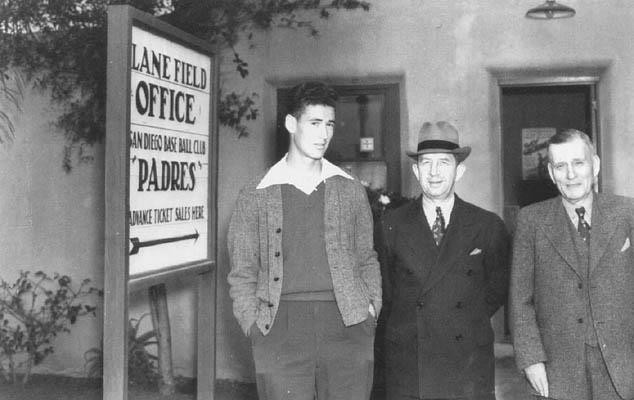
Finally! Bill Lane's luck changes! He discovers Ted Williams and... sells him to Eddie Collins of the Red Sox. Oh, well... |
⁵—"Hollywood Team Definitely Moves To Southern City," The San Bernardino County Sun, San Bernardino, California; 29 Jan 1936, Wednesday; Page 15. "William (Bill) Lane, president of the Hollywood Stars baseball club, virtually completed arrangements for moving his team from Wrigley Field to San Diego today with signing of a five-year franchise agreement with the harbor commission. Final step in the program for moving the club to San Diego will be approval of a WPA grant for renovation of sports field under direction of the commission, upon whose territory the stadium is situated."
⁶—"Behind The Line," by Dick Hyland, The Los Angeles Times, Los Angeles, California; 16 Mar 1940, Saturday; Page 12. "We need not go back too many years (Cobb is yet a comparatively young man) to find him saving the nickels he made as a food checker in a hash house so that he could amble out to Washington Park on Sunday afternoons to yell himself hoarse rooting the Angels to victory. It was not many years ago, either, that I first met him. He was then working in the kitchen in the Hollywood Brown Derby under Bill Mizner and Herb Somborne, getting $18 a week. Today he is vice-president and general manager of the Brown Derby restaurants, but that is none of our concern except that through his holding that position, the Stars came to Hollywood. The Derby's lawyer, Vic Collins, also represented Herbert Fleishhacker, and when the San Francisco banker decided to sell the Mission ball club he told Collins. Collins called Cobb, asking, 'Why don't you buy that Mission team?' Cobb's answer was double-barreled, 'What can I do with a ball club in San Francisco and what would I use for money?" ' But the seed had been planted and the idea rattled around until It sprouted the thought: Why not make the Missions a part of Hollywood? With further talk action was provoked and Cobb went to C. B. De Mille, who was busy directing a picture. 'Gimme $5000 to buy a baseball club for Hollywood,' said Cobb. He got it. He also interested Bing Crosby, Robert Taylor, Charles R. Rogers, Barbara Stanwyck, George F. Young, the marketman; Frank Mueller, Bill Frawley, Landscape Architect Benjamin Morton Purdy, Otto K. Olsen of the Hollywood Chamber of Commerce, Joe Snitzer, Gary Cooper and others, including his wife. Civic Organization They made of that ball club a civic thing. No one was permitted to invest any big money, but everyone was encouraged to take a small bite. It was to become a part of Hollywood, another asset, another evidence of growth; it was, plainly and simply, a Chamber of Commerce activity on the part of a group of people who want their little corner of the world to be better than all other corners. For it Bob Cobb is more responsible than any other single person. He started the ball rolling. Now his town gets immeasurable beneficial national publicity daily because a Missouri boy raised In Montana came West and put the Stars in Hollywood."
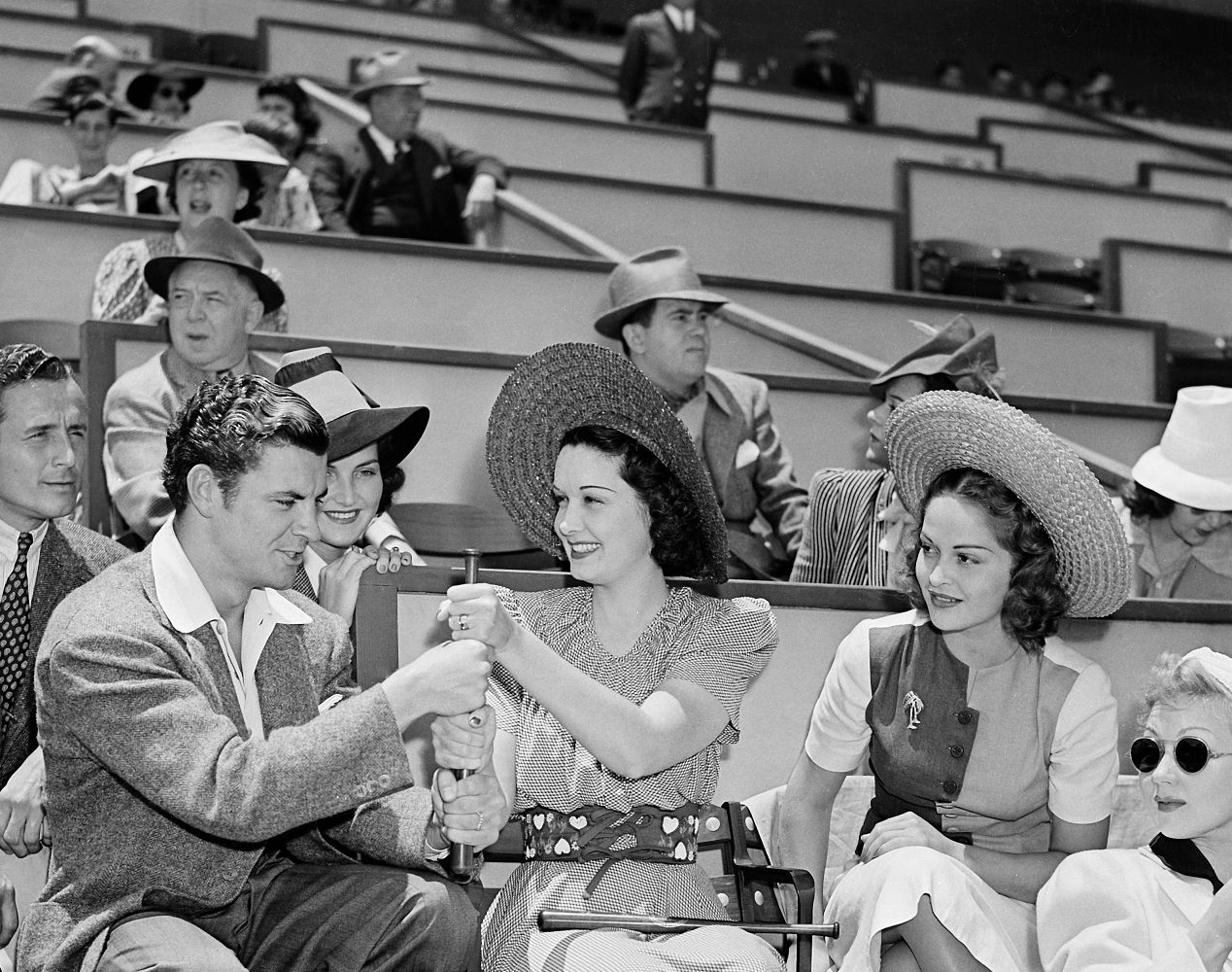
It's "Bat Day" and actor Robert Preston plays 'hand-over-hand' in Gail Patrick's box as actors Mary Healy, Ann Southern and Roger Pryor look on; Bill Frawley can't bear to watch. |
⁷—"Hollywood Goes to a Ball Game," The Los Angeles Times, Los Angeles, California; 09 Jun 1940, Sunday; Page 94. "Gail Patrick Is Baseball's Prettiest Boss," The Des Moines Register, Des Moines, Iowa; 14 Jul 1940, Sunday; Page 43. "The sulky, but sultry bride of RKO's My Favorite Wife is slender Gail Patrick. Also Gail Patrick is the graceful poser in the color photograph at right. But there's still a third Gail—peanut-cracking, perspiring and shouting boss of the Hollywood baseball team in the Pacific Coast league. QUEEN OF DIAMOND: One look at dark-eyed Gail and she wins, hands down, the title of 'baseball's most beautiful magnate.' Through her husband, Bob Cobb, proprietor of the cinema world's Brown Derby restaurants, Gail became chief owner of the $150,000 Hollywood park where the Hollywood Stars team performs before an average attendance of 6,000 fans night. 'KILL THE UMP!' Bob sold stock in the park to such stars as Bing Crosby and Robert Taylor, but when Gail gets to rooting, her wind-blown hair, flashing eyes and tomboy yells make her a greater centre of attraction than any of the stars who outrank her at the box-office. Gail's rise has been swift. Six years ago, she was tall, dark and sinister ... a winner in Paramount's contest to name a Panther Girl. Then she got $50 a week. Her movie earnings are $50,000 a year now. And the Hollywood team and park pay additional dividends." Also, "Gail Patrick: "Baseball's Most Beautiful Magnate," The_Indianapolis_Star, Sunday, May 19, 1940.
⁸—"Home Runs and Horseplay Feature Hollywood's First Game in New Ball Park," The Los Angeles Times, Los Angeles, California; 03 May 1939, Wednesday; Page 43. "Stars to Dedicate Park Against Seattle", The Los Angeles Times; Tuesday, May 2, 1939. "Stars Lose Hollywood Park Opener, 8-5", The Los Angeles Times; Wednesday, May 3, 1939
⁹—"Cochrane Seen Choice For Post," DETROIT, Oct 10 (INS): "Cochrane at present is a manufacturer's representative and the story said he has gone on a hunting trip in South Dakota but promised to give the coast officials his answer within the next 10 days. The story added that it is known that Frawley has offered Cochrane a 'handsome' salary plus stock in the ball club if he would sign and that his title would be president and he would manage the club on the field."
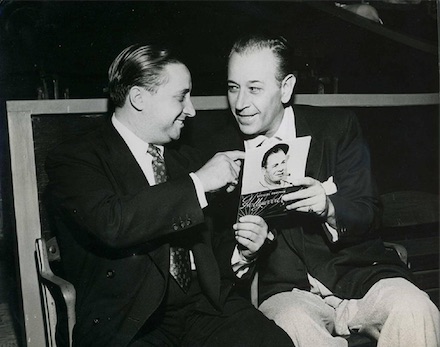
The "Munificent Mr. Malaprop," Danny Goodman, with George Raft (above) and George Burns (below).
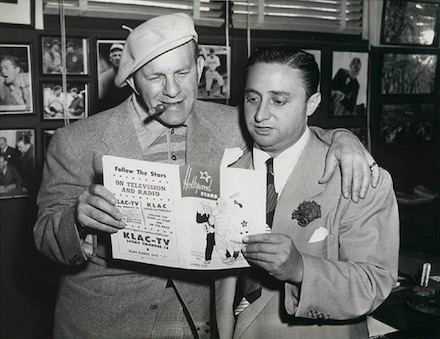 |
¹º—"Cronin 's Corner'," by Ned Cronin, The Los Angeles Times, 11 Jul 1957, Thursday, Page 67: "When we opened in 1939, we had everything but a crepes suzette and I guess we would have had that if I could have figured out a way to set fire to a bun. Since then we have experimented with dozens of chef's specials not ordinarily associated with ball parks, but they are a flop in the pan and we always have to come back to our old reliables—the hot dog and hamburger. The new Hollywood owners thought a lot of motion picture people might come over here to eat and felt it would be wise to provide them with proper fare. The idea was okay, but only as far as the first part of it went. Lots of motion picture bigwigs show up—Norman Krasna, Sidney Lanfield, George Raft and dozens of others—but they pass up everything else to tie into the hot dogs and the hamburgers."
¹¹—"The Munificent Mr. Malaprop," by Charles Maher, The Los Angeles Times, 29 Aug 1971, Sunday; Page 41 (Part 2); For more, The (Movie) Hollywood Stars Game , by Mark Langill, in the Society for American Baseball Research (SABR) PDF book, The National Pastime: Endless Seasons: Baseball in Southern California (2011). It wasn't just the minority owners who played: "Goodman's longtime association with the Friar's Club in Beverly Hills as entertainment committee chairman padded the Hollywood Stars rosters. While the Brooklyn Dodgers were winning their first championship in 1955, Goodman had been the first 'layman' honored with a roast. The toastmaster was Ronald Reagan and the dais included Jack Benny, George Burns, Phil Silvers, Dean Martin, Leo Durocher, Charlie Dressen, Red Sanders, Tom Harmon, Fred Haney, Casey Stengel, and Ty Cobb."
|
Written by Jeff Hause. Thanks to Vice President Mark Panatier of the A.F. Gilmore Company, for his assistance in the researching of this article.
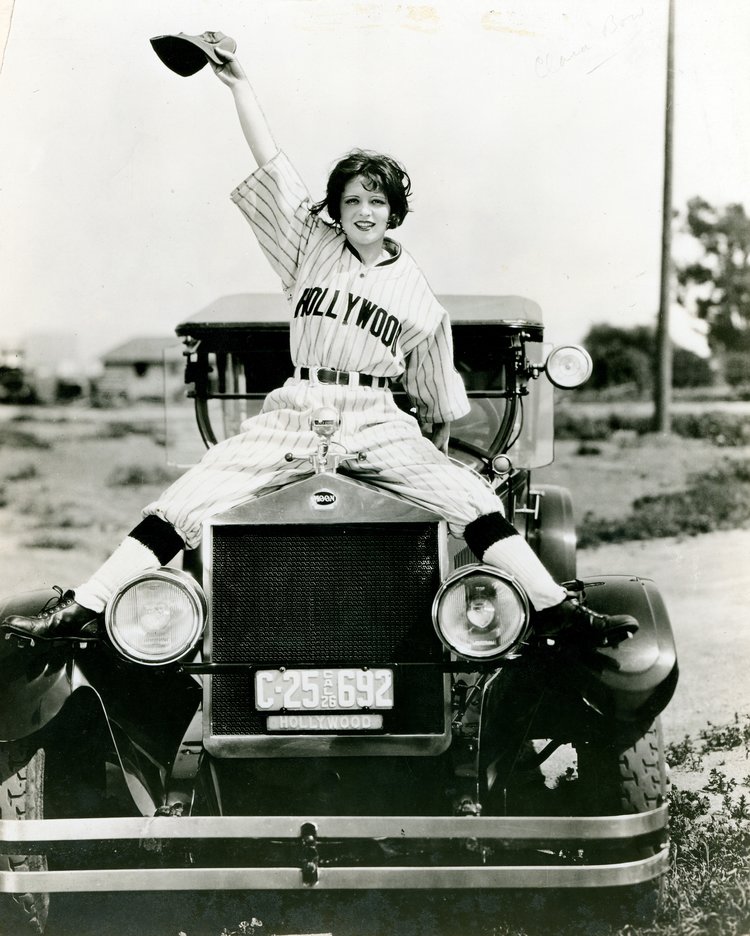
Clara Bow in 1926.
|